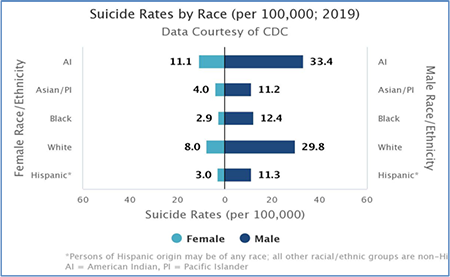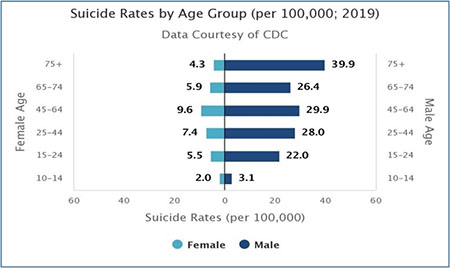Help Is Three Numbers Away
988 Suicide & Crisis Lifeline
By Imani Thompson
TA Assistant, The MayaTech Corporation
Since 2005, the National Suicide Prevention Lifeline has provided free confidential emotional support to anyone experiencing a suicidal crisis or emotional distress. Callers are routed to their nearest crisis center to receive immediate counseling and local mental health resources 24 hours a day, 7 days a week, across the United States. In 2019, the Federal Communications Commission (FCC) recommended using 988 for the National Suicide Prevention Lifeline due to increasing rates of suicide and serious emotional disturbances. The use of 988 will increase accessibility and assist in the delivery of treatment and services in real time. According to the Centers for Disease Control and Prevention (CDC) suicide was the second leading cause of death for individuals ages 10 to 34 in 2019.1 It also was the tenth leading cause of death in the nation, with more people dying by suicide than in car accidents and more suicide deaths than homicide and AIDS deaths combined.2 When examining suicide rates by gender, the rate for males was 3.7 times higher (22.4 per 100,000) than females (6.0 per 100,000), with rates highest for females ages 45 to 64 and males age 75 and older. When reviewing suicide rates by race/ethnicity, rates of suicide were highest for American Indian non-Hispanic males (33.4 per 100,000) and American Indian non-Hispanic females (11.1 per 100,000), followed by White non-Hispanic males (29.8 per 100,000) and White non-Hispanic females (8.0 per 100,000).3


With the onset of the COVID-19 pandemic, the rate of suicide attempts, and deaths continued to increase, but not only for adults. CDC data indicated an increase in emergency department visits among adolescents ages 12–17 for suspected suicide in May 2020.1 In 2020 alone, 12.2 million individuals (about twice the population of Arizona) age 18 or older reported having serious thoughts of suicide, and 1.2 million adults attempted suicide during that year.3 There is a demonstrated need for and increased attention to suicide prevention for youth and adults in the United States.
Since its establishment in 2005, the National Suicide Prevention Lifeline has received more than 20 million calls.4 In alignment with the Substance Abuse and Mental Health Services Administration’s (SAMHSA) focus on providing crisis services to anyone, anywhere, and anytime, the National Association of Mental Health Program Directors held a series of expert panels and listening sessions that found a great need for an updated response services system. The findings also indicated that the updated system would need to be equitable and accessible, trauma-informed, culturally appropriate, and address all aspects of the continuum of care. In August 2019, as a result of their findings and continued research, FCC staff, SAMHSA, the Department of Veterans Affairs, and the North American Numbering Council released a report recommending using 988 as the 3-digit phone number for the National Suicide Prevention Lifeline.5 In July 2020, the FCC designated 988 as the new phone number for the National Suicide Prevention Lifeline. In November 2021, the FCC approved text messaging access for 988 to provide swift access to those in need.
The shift to 988 will significantly transform the system of crisis care by providing access and connecting those in need with trauma-informed mental health specialists, who can provide immediate crisis intervention, and follow-up for needed servicing. The required transition of the current National Suicide Prevention Lifeline number to 988 will take effect on July 16, 2022. This transition will not only make calls easier and faster but will provide safe and effective regionally based nationwide support through crisis services, interventions, and care for individuals across the country.
Before July 16, 2022, if you or someone you know is experiencing a mental and/or emotional health crisis, please call the National Suicide Prevention Lifeline at 1-800-273-8255 (TALK). Individuals who need help but prefer to communicate via text may contact the Lifeline through online chats. Text to 1-800-273-8255 (TALK) will remain operational during the 988 transition and after it is completed. Service members, veterans, and their families may reach the Veterans Crisis Line now and after July 16, 2022, by either texting 838255, or through an online chat portal on the Veterans Crisis Line’s website.
Resources:
- 988 Suicide and Crisis Lifeline
- Crisis Text Line 741741
- National Alliance on Mental Illness
- National Institute of Mental Health Suicide Prevention
- National Suicide Prevention Lifeline
- National Suicide Prevention Lifeline Chat
- Suicide Prevention Resource Center
- Trans Lifeline
- The Trevor Project
- Trevor Space
- Veterans Crisis Line
References:
- https://www.cdc.gov/mmwr/volumes/70/wr/mm7024e1.htm?s_cid=mm7024e1_w
- Suicide Prevention By the Numbers. National Suicide Prevention Lifeline. (n.d.). Retrieved May 10, 2022, from https://suicidepreventionlifeline.org/by-the-numbers/
- https://www.nimh.nih.gov/health/statistics/suicide?utm_source=SAMHSA&utm_campaign=6591656d61-SAMHSA_Announcement_2022_01_10_1600601&utm_medium=email&utm_term=0_ee1c4b138c-6591656d61-168199545
- Gould, M.S., Lake, A.M., Galfalvy, H., Kleinman, M., Munfakh, J.L., Wright, J. and McKeon, R. (2018), Follow‐up with Callers to the National Suicide Prevention Lifeline: Evaluation of Callers’ Perceptions of Care. Suicide Life Threat Behav, 48: 75-86. doi:10.1111/sltb.12339
- https://docs.fcc.gov/public/attachments/FCC-21-119A1.docx